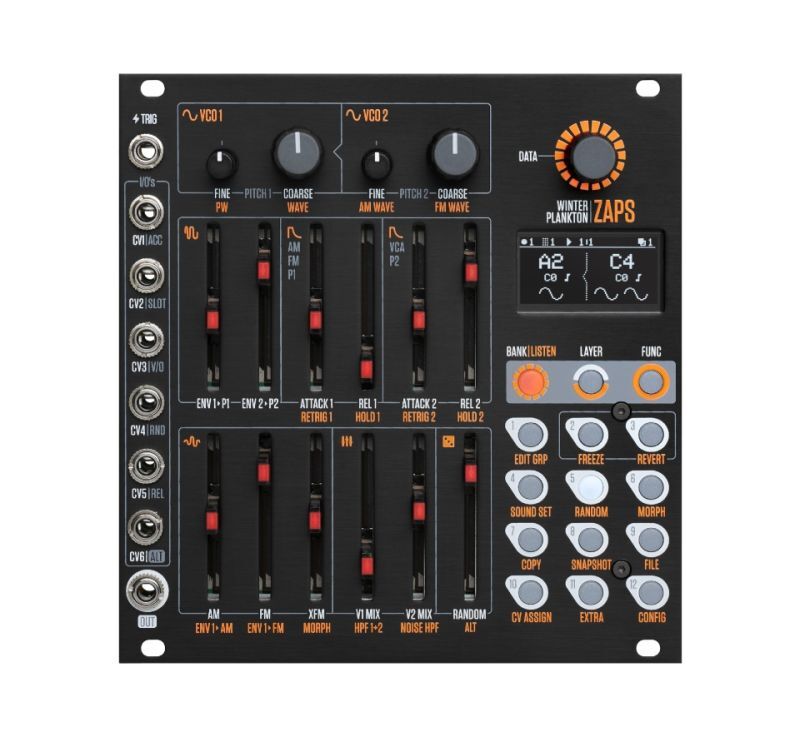商品詳細
Winter Modular/Plankton Electronics ZAPS
販売価格はお問い合わせください。
- Tweet
商品詳細
From Plankton Electronics and Winter Modular, Zaps is a percussion-line synth voice designed for creating organic sequences that can mutate over time.
These are some of the things that can be done with it:
- Sequence Preset Slots externally for changing percussion or synth lines
- Add subtle randomness to any parameter for slightly changing sounds, or go wild for unpredicted surprises on every trigger
- Morph sounds between Slots
- Assign accent to any parameter for added expressiveness
- Randomly generate full banks of sounds
- Capture any randomly generated sound into a preset slot for further editing
- Freeze/Revert the state of the module for careless editing during live performances
- Live editing of a single or multiple Slots simultaneously for expressive tweaking
- Generate melodic percussion or synth lines with the V/O tracked oscillators
- Use CV-in control of any parameter or CV-out control for external modules (control FX-sends or automate external-synth parameters)
Description
Zaps is a percussion-line-synth voice designed for creating organic percussive sequences that can mutate over time.
It uses a combination of different techniques like controlled randomness, morphing, and storing (or locking) synth-voice parameters in externally sequencable CV-controlled slots.
The synth voice is a digitally-controlled-two-oscillator-FM and AM-analog engine with two envelopes and cross-modulation.
FEATURES
SYNTHESIS
The synthesis board is an analog circuit with two VCOs, two envelopes, AM, FM, high-pass filters, and a two-channel mixer.
VCOs:
- Triangle core VCOs with V/oct inputs and Fine and Coarse controls.
- VCO 1 waves: Sine, Triangle, Sawtooth, and PWM.
- VCO 2 waves: Sine, Triangle, Sawtooth, Square, and White Noise.
- VCO2 has two separate wave outputs, one for the AM and the other for the FM and the Mixer-Channel 2.
- Self-tuning: As the analog VCOs are digitally controlled, we are now capable of offering a self-tuning function. The VCO will track perfectly each note that is played around all the audible range. The units will come factory calibrated, but the self-tuning function will be available on the menu in case of necessary.
- Synced start: the waves can be reseted at its zero point on each trigger to avoid audible “clicks” when using low frequencies and fast attack times.
ENVELOPES:
- Two AHR (Attack, Hold, Release) digital super fast envelopes.
- The hold time can be set internally or externally (Gate ON) for each envelope.
- Envelopes can be switched from logarithmic to linear responses.
- Each envelope can control the Pitch/Tone of the VCOs (Pitch Envelope), the amount of AM or FM (Envelope 1), the VCA for both channels (Envelope 2).
- Retrigger function: each envelope has its independent retrigger parameters. From 0 to 15 steps and 3 modes of time distribution: lineal, logarithmic and exponential. A dedicated “time” fader controls the time between steps.
AM:
- The amplitude modulation goes from VCO2 to VCO1.
- It can be set in two ways: straight to VCO1 or through a VCA controlled by Envelope 1.
Through Zero FM:
- The frequency modulation goes from VCO2 to VCO1 and from VCO1 to VCO2 (XFM).
- FM can be set in two ways: straight to VCO1, or through a VCA controlled by Envelope 1.
MIXER:
- Two-channel mixer for the two VCOs.
HIGH-PASS FILTER
- There are two HPFs. HPF1 filters the mixer output. HPF2 filters the white noise.
DIGITAL CONTROL
STRUCTURE:
- Each project contains twelve banks; each bank contains twelve slots; each slot contains a sound.
- All projects are stored on an SD card.
RANDOM:
- Randomize values on a per trigger basis
- Independent random control for each synth parameter
- Set ranges to any random value for controlled randomness
- Relatively attenuate all parameter-random amounts with a single global random fader
- Populate slots or banks with randomly generated sounds
FREEZE/REVERT :
- Take a snapshot of the whole project, modify it and go back to the original state.
MORPH:
- Parameter interpolation between two slots on a per trigger basis.
- Control the balance between the two slots with one fader — crossfade style!
CV ASSIGN:
- Any of the six CV-connectors can be configurable as both inputs or outputs and set to different ranges (0/10V, 0/8V, -5/5V, 0/5V).
- CV-inputs can be internally attenuated
- Control almost any synth parameter, value, or setting on a per trigger basis. For example, Accent, Slot Selection, Morph assignments, Next/Prev Slot, Random Slot, Oscillator-Wave Selection, any of the synth parameters (Pitch, Release, AM, FM, Global Random…) or any of the random parameters (Random Pitch, Random Filter, Random Hold…)
- Output any parameter-CV values through any of the assignable I/Os
- Alt-fader-CV output for controlling external parameters, like Send-FX for each slot.
- CV-slot/Gate out — Useful for externally recording finger drumming!
ACCENT ASSIGN:
- Add dynamics by assigning the accent input to control any one of the synth parameters
COPY:
- Copy Slots (also between banks)
SNAPSHOT:
- Take a snapshot of the last sound heard (flatten the values for further editing), including the effects of CV-in, Morph, and Random. Very useful for easily creating banks from scratch!
EDIT ALL:
- Action over faders has an effect on the twelve Slots. Absolute and relative modes. Use hints: Live tweaking, homogenize, “tame” a Sound Bank, or modify all Slot parameters while sequencing the Slots via CV-input.
FILE SYSTEM:
- Save, Load, Name, and Rename projects, banks, sounds and sort them into folders.
Zaps_Manual
*** お問い合わせ&予約受付中 ***
当店で扱っている各商品は大量生産ではありません。 メーカーにも在庫に限りがあります...
確実に欲しい商品に関しては早めに予約/在庫確認する事をおすすめします...
尚、お取り寄せをしなければいけない場合の納期は大抵3~5週間位と思っていただければ幸いです。





